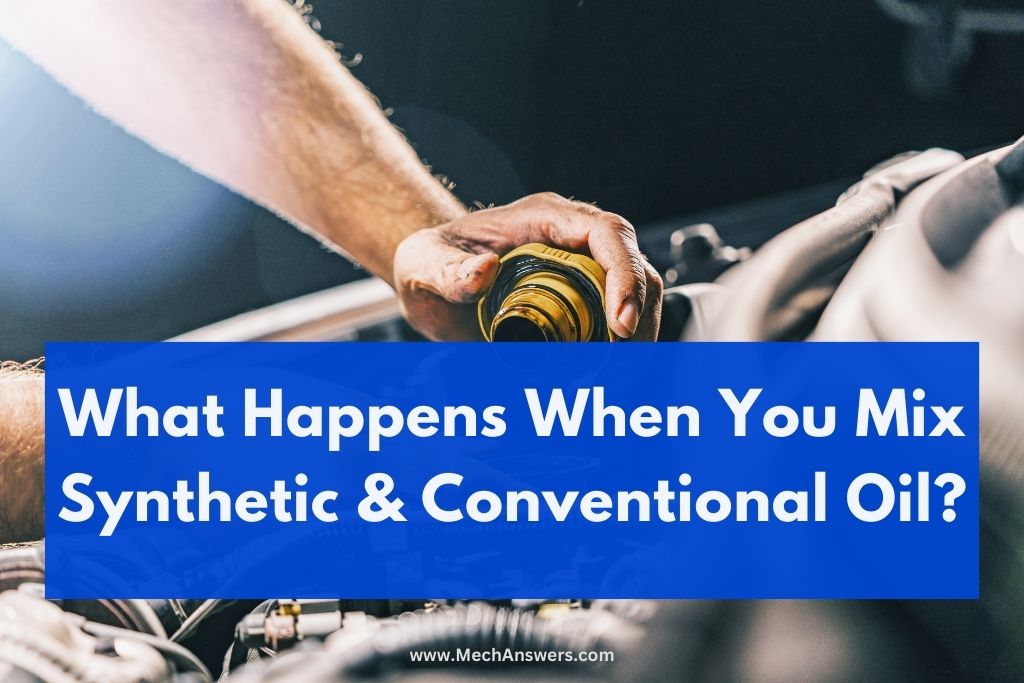Can you mix conventional and synthetic oils? The engine of a car needs oil to run smoothly. It lubes up moving parts, helps cool the engine, thwarts rust, and disintegration, and dispenses with soil and garbage. Two types of motor oil are available today: standard oil and made oil. While engineered oil is fabricated through substance compounds, traditional oil is refined from raw petroleum stolen from the ground.
Many auto owners are concerned about the possibility of mixing these two kinds of oil. This article will examine the distinctions between engineered and ordinary oils and whether and how they can be consolidated.
Outline of Customary Oil
Regular engine oil has been utilized in cars for over 100 years. It starts with earth-obtained raw petroleum that is intensely refined to eliminate contaminations. Different added substances are mixed to update properties like thickness, security from breakdown, and ability to suspend contaminations. Customary oils are explored by their consistency, which assesses the oil’s insurance from the stream.
Grades like 5W-30, 10W-40, etc, are characterized by the General Public of Car Specialists (SAE). The consistency of the oil at high temperatures is addressed constantly, while the thickness of the oil at low temperatures is addressed by the principal number (the “W” represents winter). Therefore, 5W-30 oil flows more easily than 10W-40 at cold temperatures.
Manufactured Oil Outline
Specialists can express sub-nuclear properties to make an oil custom-fitted for tip-top execution. Most of the engineered materials join up to three base liquids:
1) The synthetic base stocks that are utilized the most frequently are polyalphaolefins (PAOs). They are made in a unique way out of natural polymers to have a uniform subatomic structure.
2) A liquor and a natural corrosive response to make esters. They are frequently added as an additive to make PAO base oils cleaner and more miscible. Some predominants show that manufactured materials use an ester as the fundamental base fluid.
3) Alkylated aromatics improve an oil’s viscosity and temperature stability. By joining benzenes with other oil-based goods, they are made.
Despite the base oil, created materials contain added substances like those in customary oil to overhaul supportive properties. Due to the potent additives and specially formulated base oil, synthetic oils have the potential to significantly outperform conventional oils in several vital areas:
Pros:
– Stays aware of thickness and straightforwardness at exceptionally high and very low temperatures
– Goes against warm breakdown and oxidation, inciting longer change extends (routinely 7500-10,000 miles or more)
– Gives predominant wear confirmation under crazy conditions
– Further creates effectiveness through the less complicated stream and diminished contact
– Keeps engines cleaner by restricting stores and slop
Comparing Synthetic and Conventional Oils
Before deciding whether or not conventional and synthetic oils can be combined, it is helpful to look at the following key differences: – Greater expense per quart than ordinary oil – Not needed for regular suburbanite driving circumstances – Slight gamble of breaks in motors already utilizing traditional oil only.
1. Consistency – Both conventional and designed oils are available in ordinary multi-grade viscosities (5W-20, 5W-30, 10W-30, etc). In any case, fabricated materials have better consistency strength over a more extensive temperature range. Neglected, 5W-30 manufactured oil streams as effectively as a 5W-30 traditional oil; however, when the motor warms up, the engineered oil retains its consistency better. This further creates both wear affirmation and mileage.
2. Security Against Oxidation: Engine oil is exposed to heat, air, and burning effects that can eventually cause it to oxidize and separate. Regular oils will, by and large, oxidize faster, inciting thickening, extended causticity, and the plan of stain and sludge. Because the engineered base oils are more oxid-resistant, they can keep motors running longer without changing.
3. Volatility: The rate at which the oil evaporates when heated is called volatility. Conventional oils contain a more comprehensive range of molecule sizes, some of which are light, small molecules that evaporate at high temperatures. Emissions rise, and oil consumption increases as a result. The uniform medium-sized atoms that make up artificial materials better resist dissipation.
4. Cold Stream – In a crisp environment, motor oil needs to stream successfully to quickly lube up the engine at startup. Conventional oils’ paraffin wax can freeze and thicken, preventing proper flow. Fabricated materials don’t contain wax and typically have a low pour point, allowing them to flow quickly in cold temperatures.
5. Advanced Additives in Conventional and Synthetic Oils : Innovation from Added Substances Cleansers, dispersants, agents to prevent cancer, and grinding modifiers are examples of added substances used in conventional and manufactured oils to support execution. Synthetic oils, on the other hand, can use more advanced additives in more significant quantities. For instance, most synthetic materials contain a lot of zinc dialkyl dithiophosphate (ZDDP), which provides unparalleled wear protection even under extreme pressure.
Could you Blend Customary and Manufactured Oil?
It is safe to combine conventional oil with synthetic oil. Manufactured mix engine oils are a premixed mix of manufactured and customary oils that are broadly utilized today. Blending fabricated materials with customary oil won’t hurt a motor, yet it will weaken some of the engineered oil’s predominant properties. Use the oil type and viscosity recommended in your vehicle’s owner’s manual for best results.
When to Consider Mixing Conventional and Synthetic Oils
1.Temporary Solution for Low Oil Levels: If you don’t have the right oil on hand and your vehicle is low on oil, you can add one or two quarts of a different oil to fill it up until you can get an oil change. Just make sure to use an oil with a suitable SAE thickness grade.
2. Changing from standard to designed : to advance a more prepared vehicle from ordinary to made oil, mechanics usually prescribe first changing to a designed blend as a temporary step before going fully designed. The seals can adjust due to the slow progress, reducing the likelihood of breaks. Many recent automobiles come factory-filled with full synthetic oils, so switching to them is easy.
3. Getting an engine used: Some automakers advise using break-in oil for the first few thousand miles of a new or rebuilt engine. This oil ordinarily has regular fixings and extra added substances to forestall wear. When the break-in period is over, the oil is changed to the creator, who has decided to fabricate it entirely. The humble amount of excess conventional oil left in the structure will mix in with the newly made oil without issue.
Essential Tips for Mixing Conventional and Synthetic Oils in Your Engine
– Use incredible oils from good makers. Low-priced, off-brand oils may contain inferior base stocks and additives that can harm your engine over time.
– If you switch to manufacturing, consider using oil with seal conditioners to prevent spills. Various designed materials have added substances to help seals with staying flexible.
– Continue to adhere to the oil change schedule outlined in your owner’s manual. Mixing in standard oil will reduce fake materials’ somewhat lengthy channel limits.
– Check your oil level and condition reliably. Plan an oil change if you notice an unexpected drop in oil level or, on the other hand, assume the oil looks filthy.
Conclusion
Conventional and synthetic oils can be safely combined without causing damage to a motor. The customary oil will weaken the unrivaled exhibition attributes of artificial materials. Use the oil recommended in the owner’s manual for your vehicle for the best engine protection and fuel economy. Expecting you, truth be told, to mix oil types, make sure to use first-class oils of suitable consistency, and continue to follow the proposed oil change. With authentic help and care, your vehicle’s engine will save on significant solid areas for running various miles to come.
FAQs
Q: Can you mix conventional and synthetic oils?
Yes, you can mix conventional and synthetic oils. It’s essential to ensure that both oils have a compatible SAE viscosity grade.
Q: What happens if you mix conventional and synthetic oils?
Mixing conventional and synthetic oils can temporarily reduce your oil level without causing significant harm.
Q: Will mixing oils affect my engine’s seals?
If transitioning from conventional to synthetic oil, using a synthetic blend first can help seals adjust gradually, reducing the risk of leaks.
Q: Can mixing oils improve my engine’s performance?
While mixing oils won’t harm your engine, it won’t provide the full benefits of using 100% synthetic oil, which typically offers superior protection and performance.




